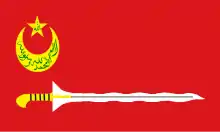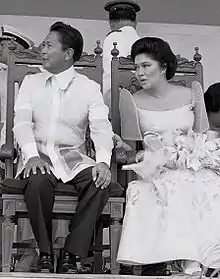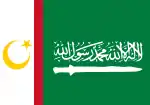Moro National Liberation Front
The Moro National Liberation Front (MNLF; Arabic: الجبهة الوطنية لتحرير مورو) is a political organization in the Philippines that was founded in 1972.[1][10] It started as a splinter group of the Muslim Independence Movement.[1] The MNLF was the leading organization among Moro separatists for about two decades beginning from the 1970s.[1]
| Moro National Liberation Front (MNLF) | |
|---|---|
 .jpg.webp) Flag and logo of the MNLF | |
| Leaders | Disputed since 1996 Nur Misuari (MNLF), Alvarez Isnaji (Isnaji group), Emmanuel Fontanilla (MNLF Spokesperson), Habib Mujahab Hashim (MNLF-ICC), Hadja Bainon Karon (MNLF Women’s Committee), Yusoph Jikiri (Sema Group), and Abul Khayr Alonto (Alonto Group)[1] |
| Dates of operation | March 18, 1968 – September 2, 1996 (as a secessionist group)[2] September 2, 1996 – present (as a political organization) |
| Headquarters | Sulu, Philippines |
| Active regions | Mindanao, Philippines |
| Ideology | Bangsamoro self-determination Egalitarianism Federalism[3] |
| Allies | State allies
|
| Opponents | State opponents Non-state opponent |
| Battles and wars | Moro conflict |
| Designated as a terrorist group by | |
| Website | mnlfnet |
In 1996, the MNLF signed a landmark peace agreement with the Philippine government that saw the creation of Autonomous Region in Muslim Mindanao (ARMM), an area composed of two mainland provinces and three island provinces in which the predominantly Muslim population enjoys a degree of self-rule.[11] Nur Misuari was installed as the region's governor but his rule ended in violence when he led a failed rebellion against the Philippine government in November 2001,[11] and fled to Sabah before being deported back to the Philippines by the Malaysian authorities.[1][12][13]
The MNLF is internationally recognized by the Organisation of Islamic Cooperation (OIC) and its Parliamentary Union of OIC Member States (PUIC).[14] Since 1977, the MNLF has been an observer member of the OIC.[15] On January 30, 2012, MNLF became an observer member of the Parliamentary Union of Islamic Cooperation (PUIC), as approved during the 7th PUIC global session held in Palembang, Indonesia.[16]
Background
The Philippine government wanted to encourage migration of landless Christians from other parts of the country in a so-called Homestead Program (1903–1973). There was no land titling system by the natives of Mindanao at that time, and the Christian settlers exploited the situation. Lanao and Cotabato received an influx of migrants from Luzon and Visayas. Tensions between Moros and Christians were caused by disputes about land ownership and disenfranchisement of Muslims. The Homestead Program is one of the root-causes of the Moro conflict.[17][18]
Poverty, grievances of the Muslim population, weak rule of law and difficult terrain have made counterterrorism challenging against insurgents in the Southern Philippines.[19]
On March 18, 1968 there was an alleged massacre of Moro soldiers in Corregidor Island.[20][21] There has been a long-standing allegation that Malaysia provided the initial training and arming of the first batch of MNLF cadres known as "Top 90" in 1969.[22] Likewise, it has also been alleged that Malaysia was either seemingly ignorant or tolerated the illicit arms shipments, mainly from the Middle East, flowing into Mindanao that fueled the insurgency.[23]
The founder and former leader of the MNLF is Nur Misuari.[1] The MNLF was founded as a splinter group of the Muslim Independence Movement on October 21, 1972.[1]
MNLF officially claims that its ideology is egalitarianism, and it is not a religious organization like its Islamic splinter group the Moro Islamic Liberation Front.[24]
Leadership and splits
The MNLF was the leading organization among Moro separatists for about two decades beginning from the 1970s. However, discontent on Nur Misuari's leadership caused the group to unravel especially after the 1996 peace agreement. Integration of former rebels in the society was also a factor in the weakening. At the present there are multiple competing factions. For instance, Hadja Bainon Karon's faction supported peace deal in 2012, after Nur Misuari had criticized it.[1][25][26][27] There was also a case of defections of Moro Islamic Liberation Front (MILF) fighters to MNLF.[28] As of 14 August 2015, the current chairman of the group is uncertain and the sources, including Organisation of Islamic Cooperation and Philippine Government, disagree. Nur Misuari still has support among some of the factions.[1]
Many splits followed tribal affiliation.[1] United Nations Security Council report stated in 2010 that the splinter groups Moro Islamic Liberation Front and Abu Sayyaf recruit and use child soldiers in the conflict.[29]
Peace talks
Libyan and Muammar Gaddafi's mediation resulted in the Tripoli Agreement on December 23, 1976. It would have established an autonomous region and given Moros influence on foreign policy, military, education, courts, and finances. Areas such as Basilan, Palawan and Sulu would have been included in the autonomous region. The plans failed due to president Ferdinand Marcos' decision to hold a referendum on each area that was to be included in the autonomous region. Most of the regions did not have a Muslim majority. The referendums however did influence Autonomous Region in Muslim Mindanao by creating its predecessors. MNLF decided to continued armed struggle.[1]
The MNLF shifted from demands of full independence to autonomy in the 1980s. In 1986 a ceasefire and attempts to have a peace agreement were made, but they failed.[1]
Autonomous Region in Muslim Mindanao was established in 1989, despite opposition from the MNLF.[1]
OIC, Libya and Indonesia mediated peace talks which were restarted in 1992. Statements of Understanding and Interim Agreements were made between 1992 and 1996. Jakarta Peace Agreement was signed in 1996.[1]
Tensions between the Philippine Government and the MNLF have been fueled by mineral wealth sharing, problems of implementing the peace agreement and the Nur Misuari faction's ongoing opposition of the peace agreement.[1][30]
In 2015 Nur Misuari rejected reports on the MNLF involvement in the North Borneo dispute and said only the Sultanate of Sulu can pursue the negotiations for the Sabah claim with the Malaysian sides. The MNLF has asserted that their group are not involved in any part of the North Borneo dispute and stressing it is a non-issue as Sabah has become the "home-base for different tribal groupings of Muslims from different regions of Southeast Asia that have enjoyed peaceful and harmonious co-existence with the Chinese and Christian populace in the area."[31]
European Union and the United States do not use the classification of "terrorist" for the MNLF.[32]
Zamboanga City crisis
.jpg.webp)
In 2013, the Nur Misuari faction of the MNLF declared independence for the Bangsamoro Republik and attacked Zamboanga City. During the MNLF standoff with the Armed Forces of the Philippines, the group was accused by the Philippines of using civilians as human shields, thus leading the Philippine government to label them terrorists.[33][34][35][36] The State Department of the United States included a mention of the siege in its report on "East Asia and Pacific Overview".[37]
Present

Currently, the Moro National Liberation Front under Nur Misuari is still in talks with President Rodrigo Duterte. Misuari has been meeting with Duterte ever since the signing of the Bangsamoro Organic Law (BOL) in Davao City. Duterte is also considering autonomy to be given to Misuari.[38] Misuari also talked with Duterte about Federalism[39] according to Presidential Spokesperson Harry Roque.[40]
Under Yusoph Jikiri and Muslimin Sema Group, they are part of the Bangsamoro Transition Commission with the Moro Islamic Liberation Front. Jikiri and Sema along with wife Congresswoman Bai Sandra Sema supports the Bangsamoro Organic Law.[41][42]
Flag
.svg.png.webp)
The Moro National Liberation Front makes use of a flag consist of a golden yellow star and crescent and a kris on a red field. The star represents Truthfulness, Fairness, Equality and Tolerance while the crescent moon symbolizes wisdom. The kris symbolizes strength. The red field represents the Bangsamoro activism, decisiveness, persistence, frugality, and sacrifices in pushing forward the revolutionary struggle for survival, self-determination, and success. The flag design is secular despite having a star and crescent, a symbol often associated with Islam. The flag has not been standardized and many variation exists regarding the scaling of elements in the flag. A variant, with a shahadah on the star and crescent exists. The flag was also used for the Bangsamoro Republik, a widely unrecognized state declared by the group.[43]
References
- Daniel Cassman (August 14, 2015). "Moro National Liberation Front". Mapping Militant Organizations – Stanford university.
- gov.ph
- http://pcij.org/blog/wp-files/podcasts/Nur.mp3
- Teoh El Sen (March 14, 2013). "MNLF supports Sulu claim, says Nur Misuari faction". Astro Awani. Retrieved June 13, 2014.
- "Nur Misuari involved, says Zahid". Bernama. MySinChew English. July 16, 2014. Archived from the original on July 16, 2014. Retrieved July 16, 2014.
- "Press Statement: Meeting with the Secretary of Foreign Affairs of the Philippines, H.E. Albert F. del Rosario on 4 March 2013". Ministry of Foreign Affairs, Malaysia. March 5, 2013. Archived from the original on March 8, 2013. Retrieved March 7, 2013.
- Edwin O. Fernandez (March 20, 2013). "Misuari hit for claiming Malaysia used MILF to bolster claim on Sabah". Philippine News Agency. Interaksyon. Archived from the original on October 25, 2015. Retrieved October 25, 2015.
- Ruth Cabal (November 8, 2016). "EXCLUSIVE: MILF 'traitors' and 'criminals' – Misuari". CNN Philippines. Retrieved November 9, 2016.
- "Press Statement: Meeting with the Secretary of Foreign Affairs of the Philippines, H.E. Albert F. del Rosario on 4 March 2013". Ministry of Foreign Affairs, Malaysia. March 5, 2013. Archived from the original on March 8, 2013. Retrieved March 7, 2013.
- "Focus on the Philippines". Archived from the original on March 5, 2016. Retrieved January 26, 2015.
- "The Philippines and Terrorism". Anti-Defamation League. April 2004. Archived from the original on May 5, 2015. Retrieved May 5, 2015.
- Barbara Mae Dacanay (December 20, 2001). "Nur Misuari seeks asylum in Malaysia". Gulf News. Archived from the original on July 5, 2014. Retrieved July 5, 2014.
- "Nur Misuari to be repatriated to stand trial". Australian Broadcasting Corporation. December 20, 2001. Archived from the original on July 5, 2014. Retrieved July 5, 2014.
- "PUIC". Retrieved January 26, 2015.
- List of Observer Members of Organization of Islamic Conference
- "PUIC Approved MNLF as Observer in Palembang Meet".
- dtic.mil/cgi-bin/GetTRDoc?AD=ADA406868
- Damien Kingsbury; Senior Lecturer in International Development Damien Kingsbury; Costas Laoutides (March 5, 2015). Territorial Separatism in Global Politics: Causes, Outcomes and Resolution. Routledge. p. 55. ISBN 978-1-317-63139-2.
- "Terrorism Havens: Philippines". Council on Foreign Relations. Retrieved January 26, 2015.
- Marites Dañguilan Vitug; Glenda M. Gloria (March 18, 2013). "Jabidah and Merdeka: The inside story". Rappler. Archived from the original on September 13, 2015. Retrieved May 6, 2016.
- Senator Benigno S. Aquino Jr. (March 28, 1968). "Jabidah! Special Forces of Evil?". Delivered at the Legislative Building, Manila, on March 28, 1968. Government of the Philippines. Retrieved May 6, 2015.
- Tan, Andrew T/H. (2009). A Handbook of Terrorism and Insurgency in Southeast Asia. Cheltenham, UK: Edward Elgar Publishing. pp. 230, 238. ISBN 978-1847207180.
- Lino Miani (2011). The Sulu Arms Market: National Responses to a Regional Problem. Institute of Southeast Asian. pp. 72–. ISBN 978-981-4311-11-3.
- "Asia Times Online :: Moro leader looks for united front". Retrieved January 26, 2015.
- "MNLF official appeals for support for peace deal". philstar.com. Retrieved January 26, 2015.
- "Abu splits into smaller groups, says MNLF official". philstar.com. Retrieved January 26, 2015.
- "Misuari to Abu Sayyaf: Enough, we cannot tolerate you forever". Retrieved January 26, 2015.
- "Al Jazeera reports exodus of MILF members to MNLF". ABS-CBN News.
- "a/64/742 – E". www.un.org. Retrieved April 3, 2018.
- "MNLF technical panel 'walks out' in final peace agreement talks". Tempo – News in a Flash. Archived from the original on May 3, 2013. Retrieved January 26, 2015.
- Karlos Manlupig (May 17, 2015). "MNLF denies talks with Malaysia over Sabah". Philippine Daily Inquirer. Archived from the original on May 17, 2015. Retrieved May 18, 2015.
Misuari, who is hiding after the hostilities in Zamboanga in 2013, maintains his position that only the Sultanate of Sulu can pursue the negotiations for the Sabah claim. Respecting the fervent wish of the late Sultan Muhammad Jamalul Kiram III to let alone the Islamic Sultanate of Sulu and North Borneo (SSNB) to negotiate peacefully with the Muslim leaders of Malaysia to settle the controversial issue in order not to repeat the March 2013 Lahad Datu, Sabah incident, Chairman Misuari has dismissed the media reports as unfounded and without any ounce of truth involving the MNLF in any level talks. The MNLF, however, asserted that the Sabah case is a non-issue because it is the "home-base for different tribal groupings of Muslims from different regions of Southeast Asia that have enjoyed peaceful and harmonious co-existence with the Chinese and Christian populace in the area.
- "Moro National Liberation Front". Mapping Militant Organizations.
- Carmela Lapeña; Amita Legaspi (September 9, 2013). "MNLF attacks Zambo City, using 20 hostages as 'human shields;' six killed". GMA News. Reuters. Retrieved September 10, 2013.
- Titus Calauor; Benjie Vergara; Al Jacinto (September 11, 2013). "Human shields beg for help". Agence France Presse. The Manila Times. Archived from the original on October 25, 2015. Retrieved September 12, 2013.
- Senator Aquilino "Koko" Pimentel III (November 27, 2013). "Resolution directing the appropriate Senate Committee's, to conduct an inquiry, in aid of legislation, on the motives, behind the Zamboanga City siege in September 2013 which resulted in a humanitarian crisis in the said city, with the end in view of enacting measures to prevent the reccurrence of a similar incident in the future" (PDF). Philippine Senate. Retrieved November 28, 2013.
- News, from a report by Atom Araullo, ABS-CBN. "Misuari declares independence". abs-cbn.com. Retrieved April 3, 2018.
- "Chapter 2. Country Reports: East Asia and Pacific Overview". U.S. Department of State. U.S. Department of State. 2013.
- News, Dharel Placido, ABS-CBN. "Duterte, Misuari in first meeting since Bangsamoro Law signing". ABS-CBN News. Retrieved October 6, 2018.
- "Duterte, Misuari hold talks on federalism". Manila Bulletin News. Retrieved October 7, 2018.
- "Duterte meets with MNLF leader Misuari in Davao City". GMA News Online. Retrieved October 6, 2018.
- Arguillas, Carolyn O. "New Bangsamoro political entity: from ARMM to BARMM; from BBL to OLBARMM". MindaNews. Retrieved October 7, 2018.
- Viña, Antonio G. M. La. "RIVERMAN'S VISTA: Hopes raised with the Bangsamoro Organic Law". MindaNews. Retrieved October 7, 2018.
- Petalcorin, John Remollo. "FAQ About MNLF". Voice from the Resistance. Retrieved December 26, 2013.

